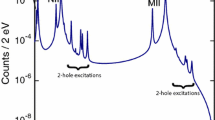Abstract
The determination of the absolute scale of the neutrino masses is one of the most challenging present questions in particle physics. The most stringent limit, \(m(\bar{\nu }_{\mathrm {e}})< 2\) eV, was achieved for the electron anti-neutrino mass. Different approaches are followed to reach a sensitivity on neutrino masses in the sub-eV range. Among them, experiments exploring the beta decay or electron capture of suitable nuclides can provide information on the electron neutrino mass value. We present the electron capture \(^{163}\)Ho experiment ECHo, which aims to investigate the electron neutrino mass in the sub-eV range by means of the analysis of the calorimetrically measured energy spectrum following electron capture in \(^{163}\)Ho. A high precision and high statistics spectrum will be measured with arrays of metallic magnetic calorimeters. We discuss some of the essential aspects of ECHo to reach the proposed sensitivity: detector optimization and performance, multiplexed readout, \(^{163}\)Ho source production and purification, as well as a precise theoretical and experimental parameterization of the calorimetric EC spectrum including in particular the value of \(Q_{\mathrm {EC}}\). We present preliminary results obtained with a first prototype of single channel detectors as well as a first 64-pixel chip with integrated micro-wave SQUID multiplexer, which will already allow to investigate \(m(\nu _{\mathrm {e}})\) in the eV range.



Similar content being viewed by others
References
G.L. Fogli et al., Phys. Rev. D 86, 013012 (2012)
K.N. Abazajian et al., Astropart. Phys. 35, 177 (2011). http://arxiv.org/abs/1103.5083
F.T. Avignone III et al., Rev. Mod. Phys. 80, 481 (2008). http://arxiv.org/abs/arXiv:0708.1033
G. Pagliaroli, F. Rossi Torres, F. Vissani, Astropart. Phys. 33, 287 (2010)
G. Drexlin et al., Adv. High Energy Phys. 2013, 293986 (2013)
C. Kraus et al., Eur. Phys. J. C 40, 447 (2005)
V.M. Lobashev et al., Nucl. Phys. A 719, 153c (2003)
V.N. Aseev et al., Phys. Rev. D 84, 112003 (2011). http://arxiv.org/abs/1108.5034v1
A. De Rujula, M. Lusignoli, Phys. Lett. B 118, 429 (1982)
A. De Rujula, http://arxiv.org/abs/1305.4857
C. Enss, Top. Appl. Phys. 99, 63–149 (2005)
A. Fleischmann et al., AIP Conf. Proc. 1185, 571 (2009)
M. Galeazzi et al., http://arxiv.org/abs/1202.4763
C. Pies et al., J. Low Temp. Phys. 167, 269 (2012)
L. Gastaldo et al., Nucl. Instrum. Method A 711, 150 (2013)
E. Kugler, Hyperfine Interact. 129, 23 (2000)
P.C.-O. Ranitzsch et al., J. Low Temp. Phys. 167, 1004 (2012)
J.A.B. Mates et al., Appl. Phys. Lett. 92(2), 023514 (2008)
S. Kempf, J. Low Temp. Phys. doi:10.1007/s10909-013-1041-0
J.W. Engle et al., Nucl. Instrum. Methods B 311, 131 (2013)
I. Usolstev et al., Nucl. Instrum. Methods A 691, 5 (2012)
P. Hohenberg, W. Kohn, Phys. Rev. 136, B864 (1964)
W.F. Egelhoff Jr, Surf. Sci. Rep. 6, 253 (1987)
M.I. Krivoruchenko, F. Simkovic, D. Frekers, A. Faessler, Nucl. Phys. A 859, 140 (2011)
M. Wang, G. Audi et al., Chin. Phys. C 36, 1603 (2012)
J.U. Andersen et al., Phys. Lett. B 113, 72 (1982)
F. Gatti et al., Phys. Lett. B 398, 415 (1997)
M. Block et al., Eur. Phys. J. D 45, 39 (2007)
J. Ketelaer et al., Nucl. Instrum. Methods A 594, 162 (2008)
J. Repp et al., Appl. Phys. B 107, 983 (2012)
C. Roux et al., Appl. Phys. B 107, 997 (2012)
Author information
Authors and Affiliations
Corresponding author
Rights and permissions
About this article
Cite this article
Gastaldo, L., Blaum, K., Doerr, A. et al. The Electron Capture \(^{163}\)Ho Experiment ECHo. J Low Temp Phys 176, 876–884 (2014). https://doi.org/10.1007/s10909-014-1187-4
Received:
Accepted:
Published:
Issue Date:
DOI: https://doi.org/10.1007/s10909-014-1187-4




